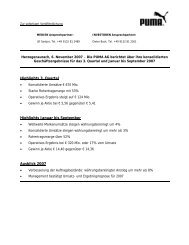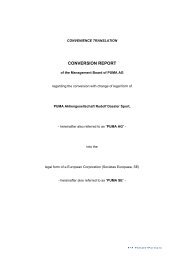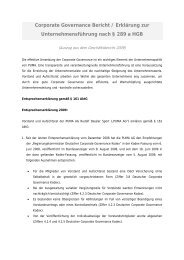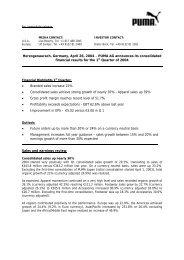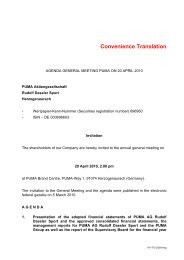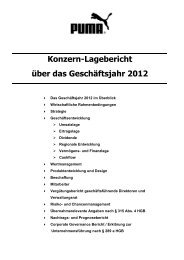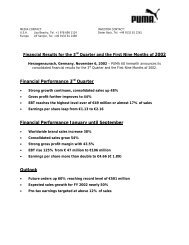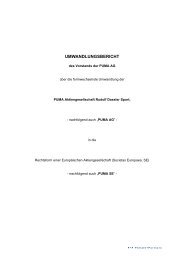Html - PUMA CATch up
Html - PUMA CATch up
Html - PUMA CATch up
You also want an ePaper? Increase the reach of your titles
YUMPU automatically turns print PDFs into web optimized ePapers that Google loves.
p : 55 | c : 3 <strong>PUMA</strong>.SAfe<br />
chemicals managemenT<br />
<strong>PUMA</strong>’s efforts to protect consumers<br />
and the environment against<br />
hazardous chemicals dates back<br />
to 1999 when we released our<br />
first Handbook of Environmental<br />
Standards. The Handbook has since<br />
provided guidance to our s<strong>up</strong>pliers, testing<br />
institutes, chemical companies and other<br />
stakeholders. It is <strong>up</strong>dated periodically to<br />
reflect the latest legal requirements and<br />
tightest industry standards.<br />
In 2012, <strong>PUMA</strong> split its established Handbook<br />
into two volumes: “Volume 1 - Environmental<br />
Management” covering all environmental<br />
related topics and “Volume 2 - Chemicals<br />
Management” covering our restricted<br />
substances list (RSL) and the Manufacturing<br />
Restricted Substances List (MRSL). The<br />
decision to have a separate handbook<br />
dedicated to the responsible<br />
handling of chemical<br />
volume 1.<br />
environment<br />
management<br />
puma.safe<br />
handbook of<br />
environmental<br />
standards<br />
› click here<br />
volume 2.<br />
chemical<br />
management<br />
<strong>PUMA</strong> BUSineSS And SUStAinABility RePoRt 2012<br />
rsl-producTs<br />
(shoes,<br />
accessories,<br />
garments)<br />
mrsl-facTory<br />
manufacturing<br />
processes<br />
(emissions to environment:<br />
air, water,<br />
ground,etc,)<br />
substances originated from <strong>PUMA</strong>’s commitment<br />
to eliminate hazardous chemicals<br />
from its manufacturing process by 2020<br />
(Zero Discharge of Hazardous Chemicals by<br />
2020). The <strong>up</strong>dated version includes a section<br />
on restricted substances in products<br />
and production, whereas test methods and<br />
limit values are included in <strong>PUMA</strong>’s RSL and<br />
MRSL. The Handbook was communicated<br />
and delivered to s<strong>up</strong>pliers and relevant<br />
stakeholders in October 2012.<br />
› please click here<br />
puma’s resTricTed suBsTances lisT<br />
and manufacTuring resTricTed<br />
suBsTances lisT<br />
To ensure consumer safety, <strong>PUMA</strong> <strong>up</strong>dates<br />
its Restricted Substances List (RSL)<br />
›› please click here in compliance with new<br />
product safety regulations including<br />
US CPSIA, EU REACH, China GB<br />
standards and all relevant coun-<br />
tries where <strong>PUMA</strong> products are<br />
distributed and sold. At the beginning<br />
of 2012 <strong>PUMA</strong> communicated<br />
to its s<strong>up</strong>pliers that no<br />
alkylphenolethoxylates (APEOs)<br />
must be used in manufacturing,<br />
lowering the limit value to 100 mg/kg.<br />
No nonylphenol, a toxic substance that<br />
can be formed from APEOs, must be<br />
detectable in <strong>PUMA</strong>s products.<br />
roadmap To Zero discharge of<br />
haZardous chemicals By 2020<br />
Our commitment to Zero Discharge<br />
of Hazardous Chemicals (ZDHC) by<br />
2020 resulted not only in a new handbook<br />
but also in a ZDHC working gro<strong>up</strong>. This industry<br />
collaboration was set <strong>up</strong> in 2011,<br />
and nine signatory member companies are<br />
working together towards an ambitious<br />
goal, guided by a joint › roadmap, a document<br />
that frames the projects and work<br />
done within the gro<strong>up</strong>. The ZDHC working<br />
gro<strong>up</strong> looks back at an intensive first year.<br />
Project <strong>up</strong>dates and further information are<br />
available on › www.roadmaptozero.com.<br />
In addition to participation in this working<br />
gro<strong>up</strong>, <strong>PUMA</strong> has realized its own action<br />
plan › please click here to materialize what<br />
<strong>PUMA</strong> has committed to. The phase-out of<br />
hazardous chemicals in the s<strong>up</strong>ply chain<br />
will be integrated into <strong>PUMA</strong>’s new Sustainability<br />
Scorecard 2015. Furthermore, <strong>PUMA</strong><br />
f.9 t.1<br />
80,00<br />
70,00<br />
60,00<br />
50,00<br />
40,00<br />
30,00<br />
20,00<br />
10,00<br />
0,00<br />
25<br />
puma voc daTa 2003 – 2012<br />
66.72<br />
56.22<br />
46.84<br />
has encouraged strategic s<strong>up</strong>pliers to disclose<br />
their chemicals management systems<br />
in their own sustainability reports starting<br />
2012. First reports will be published in the<br />
year ahead, and we highly appreciate this<br />
small step towards enhanced transparency.<br />
volaTile organic compounds in shoes<br />
In a quest to find more ways of using water-based<br />
chemicals, <strong>PUMA</strong> continues its<br />
monthly monitoring of the levels of volatile<br />
organic compounds (VOC) per pair of shoes.<br />
We want to make the use of chemicals more<br />
efficient and therefore reduce our use of<br />
VOC-based chemicals in our shoe production<br />
to achieve the target of 25g per pair. The<br />
chart below shows the progress of our VOC<br />
use:<br />
43.00 42.19 39.82 41.19<br />
2003 2004 2005 2006 2007 2008 2009 2010<br />
40.22<br />
Measured VOC<br />
Target<br />
37.02<br />
2011<br />
33.07<br />
2012<br />
Figure 9: Avarage VOC consumption per pair of <strong>PUMA</strong> shoes<br />
25






